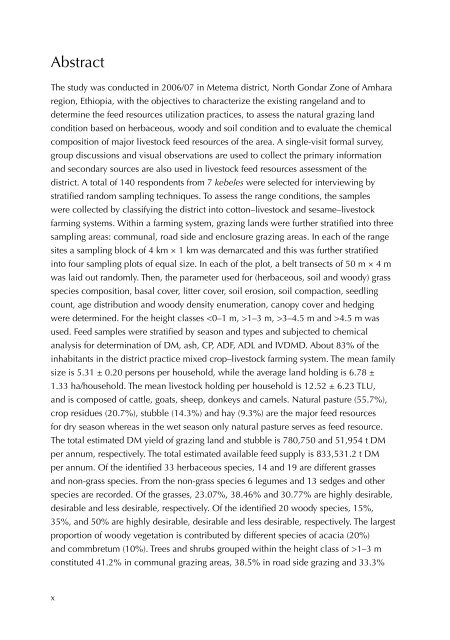Rangeland condition and feed resources in Metema District, North ...
Rangeland condition and feed resources in Metema District, North ...
Rangeland condition and feed resources in Metema District, North ...
Create successful ePaper yourself
Turn your PDF publications into a flip-book with our unique Google optimized e-Paper software.
Abstract<br />
The study was conducted <strong>in</strong> 2006/07 <strong>in</strong> <strong>Metema</strong> district, <strong>North</strong> Gondar Zone of Amhara<br />
region, Ethiopia, with the objectives to characterize the exist<strong>in</strong>g rangel<strong>and</strong> <strong>and</strong> to<br />
determ<strong>in</strong>e the <strong>feed</strong> <strong>resources</strong> utilization practices, to assess the natural graz<strong>in</strong>g l<strong>and</strong><br />
<strong>condition</strong> based on herbaceous, woody <strong>and</strong> soil <strong>condition</strong> <strong>and</strong> to evaluate the chemical<br />
composition of major livestock <strong>feed</strong> <strong>resources</strong> of the area. A s<strong>in</strong>gle-visit formal survey,<br />
group discussions <strong>and</strong> visual observations are used to collect the primary <strong>in</strong>formation<br />
<strong>and</strong> secondary sources are also used <strong>in</strong> livestock <strong>feed</strong> <strong>resources</strong> assessment of the<br />
district. A total of 140 respondents from 7 kebeles were selected for <strong>in</strong>terview<strong>in</strong>g by<br />
stratified r<strong>and</strong>om sampl<strong>in</strong>g techniques. To assess the range <strong>condition</strong>s, the samples<br />
were collected by classify<strong>in</strong>g the district <strong>in</strong>to cotton–livestock <strong>and</strong> sesame–livestock<br />
farm<strong>in</strong>g systems. With<strong>in</strong> a farm<strong>in</strong>g system, graz<strong>in</strong>g l<strong>and</strong>s were further stratified <strong>in</strong>to three<br />
sampl<strong>in</strong>g areas: communal, road side <strong>and</strong> enclosure graz<strong>in</strong>g areas. In each of the range<br />
sites a sampl<strong>in</strong>g block of 4 km × 1 km was demarcated <strong>and</strong> this was further stratified<br />
<strong>in</strong>to four sampl<strong>in</strong>g plots of equal size. In each of the plot, a belt transects of 50 m × 4 m<br />
was laid out r<strong>and</strong>omly. Then, the parameter used for (herbaceous, soil <strong>and</strong> woody) grass<br />
species composition, basal cover, litter cover, soil erosion, soil compaction, seedl<strong>in</strong>g<br />
count, age distribution <strong>and</strong> woody density enumeration, canopy cover <strong>and</strong> hedg<strong>in</strong>g<br />
were determ<strong>in</strong>ed. For the height classes 1–3 m, >3–4.5 m <strong>and</strong> >4.5 m was<br />
used. Feed samples were stratified by season <strong>and</strong> types <strong>and</strong> subjected to chemical<br />
analysis for determ<strong>in</strong>ation of DM, ash, CP, ADF, ADL <strong>and</strong> IVDMD. About 83% of the<br />
<strong>in</strong>habitants <strong>in</strong> the district practice mixed crop–livestock farm<strong>in</strong>g system. The mean family<br />
size is 5.31 ± 0.20 persons per household, while the average l<strong>and</strong> hold<strong>in</strong>g is 6.78 ±<br />
1.33 ha/household. The mean livestock hold<strong>in</strong>g per household is 12.52 ± 6.23 TLU,<br />
<strong>and</strong> is composed of cattle, goats, sheep, donkeys <strong>and</strong> camels. Natural pasture (55.7%),<br />
crop residues (20.7%), stubble (14.3%) <strong>and</strong> hay (9.3%) are the major <strong>feed</strong> <strong>resources</strong><br />
for dry season whereas <strong>in</strong> the wet season only natural pasture serves as <strong>feed</strong> resource.<br />
The total estimated DM yield of graz<strong>in</strong>g l<strong>and</strong> <strong>and</strong> stubble is 780,750 <strong>and</strong> 51,954 t DM<br />
per annum, respectively. The total estimated available <strong>feed</strong> supply is 833,531.2 t DM<br />
per annum. Of the identified 33 herbaceous species, 14 <strong>and</strong> 19 are different grasses<br />
<strong>and</strong> non-grass species. From the non-grass species 6 legumes <strong>and</strong> 13 sedges <strong>and</strong> other<br />
species are recorded. Of the grasses, 23.07%, 38.46% <strong>and</strong> 30.77% are highly desirable,<br />
desirable <strong>and</strong> less desirable, respectively. Of the identified 20 woody species, 15%,<br />
35%, <strong>and</strong> 50% are highly desirable, desirable <strong>and</strong> less desirable, respectively. The largest<br />
proportion of woody vegetation is contributed by different species of acacia (20%)<br />
<strong>and</strong> commbretum (10%). Trees <strong>and</strong> shrubs grouped with<strong>in</strong> the height class of >1–3 m<br />
constituted 41.2% <strong>in</strong> communal graz<strong>in</strong>g areas, 38.5% <strong>in</strong> road side graz<strong>in</strong>g <strong>and</strong> 33.3%<br />
x

















